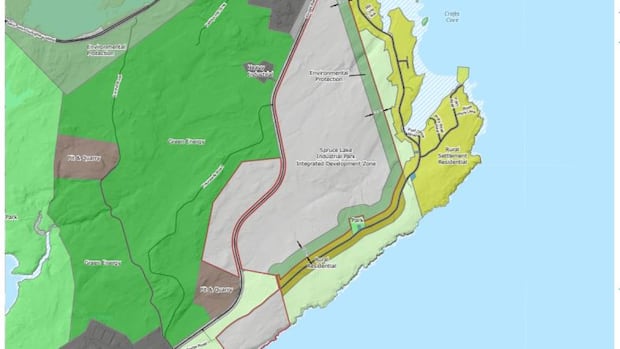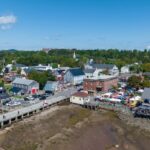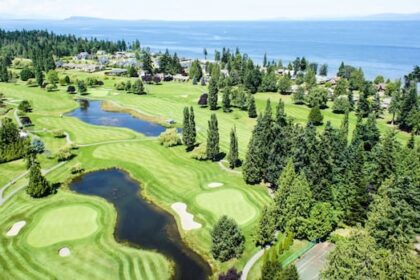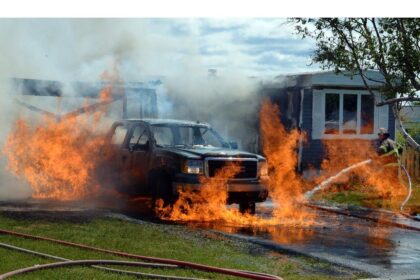New Brunswick·NewPeople who live near the Spruce Lake Industrial Park on the western outskirts of Saint John are voicing concerns after a plan to expand the park received the final green light from the province.Environmental approval comes with 23 conditions meant to mitigate impactNipun Tiwari · CBC News · Posted: Sep 01, 2025 5:00 AM EDT | Last Updated: 31 minutes agoThe Spruce Lake Industrial Park expansion is a city-led plan to make hundreds of hectares in the area ‘pad ready’ for industrial development to help attract large business operations to the city. (Roger Cosman/CBC )People who live near the Spruce Lake Industrial Park on the western outskirts of Saint John are voicing concerns after a plan to expand the park received the final green light from the province.Lorneville-area residents say the province’s environmental conditions on the development fall short and are trying to approach a new liasion committee with optimism.”We thought there would be a lot more conditions put in the EIA [environmental impact assessment],” said resident spokesperson Adam Wilkins.The Department of Environment and Climate Change approved on Aug. 20 the environmental impact assessment for the city-led expansion project, which will see more than 600 hectares prepared for development.The city and province want to attract business from green, clean and non-emitting industrial sectors to help fuel economic growth.The EIA approval comes with 23 conditions that aim to minimize the impact of the expansion. WATCH | Conditions to mitigate impact miss the mark: Residents upset after province gives Saint John industrial park expansion green lightDepartment of Environment adds 23 conditions to plans to develop more than 600 hectares at Spruce Lake Industrial Park, but residents still worry about impacts to environment, quality of life. But Lorneville residents who oppose the project say the conditions miss the mark, and they’re still concerned about impacts to the surrounding natural environment and the neighbourhood’s quality of life.Wilkins criticized a lack of precautions to protect old-growth forest in and around the site, a lack of clarity on wetland impacts, and a lack of requirement for a minimum buffer larger than 150 metres between the site and residences.The city’s plan does call for larger buffers depending on the type of development. Industrial developments considered “volatile,” for example, would require a 500-metre buffer.The approval conditions include several monitoring plans and regular reports from the city and the province’s Regional Development Corporation on the potential impacts to surrounding wells, groundwater and wetlands. It also includes mitigation steps.”I was very happy to see the level of reporting, diligence and environmental stewardship that will be required by us should we take on the development of the pad-ready sites,” said Ian MacKinnon, head of Saint John Industrial Parks, a city-owned, non-profit business group.Ian MacKinnon, general manager of Saint John Industrial Parks, says he is happy with the province’s conditions, calling them diligent in environmental stewardship. (City of Saint John)MacKinnon said it’s possible that sites in the area could be sold before they are “pad-ready,” in which case the new owner would need to follow the same conditions.The expansion was approved unanimously by council after a lengthy public hearing process in June, with the city and councillors saying Saint John has few areas with ample space for development. The city has continued to receive letters in opposition more than a month after its municipal approval.The city has created a Spruce Lake industrial zone, which would require a buffer of 150 metres. Industrial buildings would need to be 250 metres away from residences, and volatile industrial operations would require twice that distance. (City of Saint John)CBC News requested an interview with the Department of Environment and the Regional Development Corporation. Gilles LePage is minister for both departments and recused himself from the EIA process, according to a government news release in May. The Environment Department said a deputy minister signed off on the assessment in LePage’s place and didn’t address the interview request. No one from the development corporation was available for an interview.Conditions include monitoring plans and regular reportsConstruction would need to start within five years, according to the province’s website.”Monitoring plan” conditions include one for the main 150-metre vegetative buffer between the site and residential neighbourhoods to “ensure” it isn’t impacted by the development, the document says.The province also asked for a monitoring plan for wetlands, which comprise 53 hectares of the expansion site, before any are altered by development.The city and the Regional Development Corporation will also need to monitor groundwater and wells within a 500-metre radius of the site. This includes residential wells — which Lorneville residents use for drinking water — with the owner’s permission. The approval requires a contingency plan if wells or groundwater sources are impacted.Well water monitoring could be a positive, Lorneville resident Wilkins said, adding he wants more information.Permits will be needed for any construction on or within 30 metres of a watercourse or wetland and any wetland loss would need to be compensated 2:1 to the conservation group Ducks Unlimited. There are also conditions on First Nations consultations and archaeological findings.Adam Wilkins, a Lorneville resident and one of the leaders in the opposition to the expansion plan, says the conditions in the province’s approval are vague and don’t address community concerns. (Nipun Tiwari/CBC)The city and the province’s development corporation will need to submit a summary on the “status of each condition listed in the determination” every six months until they are met, or until the province says they are no longer needed. MacKinnon said the city will likely hire a consultant to aid in compliance. These deliverables will need to be submitted to the Environment Department.City and community reigniting engagement effortWilkins and MacKinnon said the industrial parks group and community will be forming a liaison committee to engage with each other. But residents have lingering negative feelings from similar committee meetings before the plan’s approval.Wilkins said community members are trying to be optimistic but are concerned the new committee will take Lorneville further away from regulatory bodies. He hopes it will lead to more headway on community questions, like those of larger buffers, details on promised community benefits and accountability.”If a business says, ‘We want to be good stewards with the community, we’ll do X, Y and Z.’ How do we make sure that X, Y and Z actually happen?” Wilkins asked.MacKinnon hopes for a reset with the community to “figure out how to best collaborate and communicate and go forward.””That’s really the intent of this first meeting. So that we learn from the past and have a positive experience going forward.”About 8 keen expressions of interestMany concerns stem from not knowing what will be developed at the site.MacKinnon said potential developments can’t be revealed due to non-disclosure agreements. He said the industrial park group is managing about eight expressions of interest “that are very keenly interested.”MacKinnon previously said there is potential for a data centre and a green manufacturing plant. Interest in those developments still exists and is “significant,” he said. ABOUT THE AUTHORNipun Tiwari is a reporter assigned to community engagement and based in Saint John, New Brunswick. He can be reached at nipun.tiwari@cbc.ca.
Province approves industrial park expansion in Saint John despite community concerns











